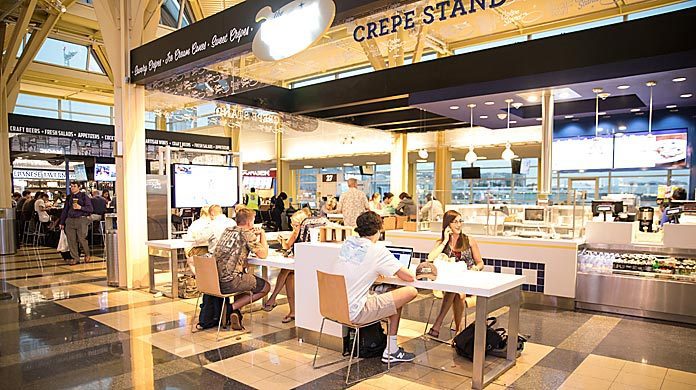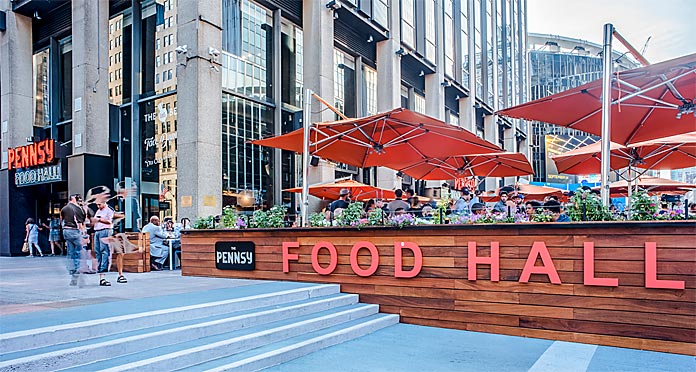
Article contributed by Joy Pouros, Culinary Software Services
Food halls are the food courts. Where malls have struggled to compete with ecommerce, and traditional restaurants wrestle with grocery delivery services, food halls seem to create an experience not easily replicated by other options.
While have been a few long-standing food halls in the US, it has only been in the past two decades that they’ve become more popular, and they have really only begun to explode in popularity as of 2015-2016. The United States may have been late to the party – food halls have been a staple in European culture since the 1800s – but we’re making up for lost time. By some estimates, there could be as many as 200 food halls across the United States in 2019.
While the technicalities are still debatable, generally speaking, food halls are open areas from which multiple food vendors sell. They are different from farmers markets in that these tend to be year-round and indoors, and while they could feature some produce vendors, food halls primarily host restaurants and prepared food vendors. What separates a food hall from the casual “food court” is the lack of fast food and the emphasis on artisanal and authentic offerings. This makes food halls more upscale, however most food halls still strive to be affordable dining options.
Despite a robust economy, low unemployment, and multiple studies showing that fewer Americans are eating at home, the food service industry has been mixed in recent years. Casual dining has suffered recently, with several large chains publicly struggling. So how are food halls succeeding? And is there enough demand to support the booming market? If the food service industry is a constantly-evolving blend of trends, food halls may have the secret recipe.
Why It Works for Consumers
“Food is not just eating energy. It’s an experience.” – Guy Fieri
While food halls have some differences from one another, they all seem to have a combination of several popular trends, making them desirable to a large population. Let’s look at some of the trends in play.
We are in the middle of a foodie culture phenomenon. Just turn on your television and see all the cooking competition shows, or scroll through social media to see a real-time account of what all your acquaintances are having for lunch. Consumers are much more interested in the art of eating than they were ten years ago. It’s not just about getting full, it’s about where you went, who you were with, and what you saw.
Food halls, by their very nature, offer variety. After all, it’s multiple vendors coming together in one space. Even in themed food halls, one of the most well-known being Eataly, with its definitive Italian focus, each restaurant, café, or other vendor has a niche. While Eataly certainly has plenty of pasta, it also has restaurants specializing in fresh seafood, vegetable-based dishes, and more.
When each restaurant has the opportunity to specialize, each chef is bringing his or her best to the table, so to speak. As such, the food is high quality and authentic. “Natural” continues to enjoy renewed popularity, as evidenced by the ever-present farm-to-table menus. Customers are enjoying seeing the plethora of hand-crafted and artisanal options. All of these trends come to life when each restaurant focuses on what sets them apart from the other vendors.
Then there’s the local appeal. Contrasting food courts, food halls steer clear of major fast food chains and focus on local and independent restaurants. That continues to align with what customers are wanting more of, and goes well with the authentic vibe food halls possess.
It’s not just the food, it’s the experience. The open concept of food halls ensure that customers get more than just a meal. While you order and eat food from one restaurant, you could be near a different vendor who is kneading dough for fresh bread, or carefully decorating baked goods.
Many food halls are expanding the experience to offer cooking demonstrations, or classes, like La Centrale in Miami. It’s this hands-on approach that adds another dimension to the experience. Customers may be able to eat food or even learn to cook from a celebrity chef or a young up-and-comer. That’s something you just don’t get at your mall food court or typical chain restaurant. And it’s not limited to food! The Chicago French Market offers live music, and many food halls offer additional shopping opportunities, though dining remains the main entrée.
While the offerings at food halls can vary wildly, from very causal to upscale or even from prepared foods to butcher shops or specialty artisanal foods, generally speaking they are fairly affordable. Yet, when you consider the atmosphere and general experience, food halls achieve a very high perceived value from customers. As with any business, that perceived value goes a long way and keeps consumers happy and coming back.
Artisanal. Specialty. Natural. Authentic. Hand-crafted. Shopping local. Affordable. Atmosphere. Instagram-worthy. All of these are buzzwords. And all of these are words that accurately describe what food halls have to offer. Put simply, they seem to have it all, which is why they are driving foot traffic and soaring in popularity.
But it takes more than consumers to make a food hall thrive. Food halls also have to make sense for chefs, restaurant owners, and property owners.

Why It Works for Restaurants and Property Owners
“When you’re running a restaurant, you have to change with the times; otherwise, the times will change you.” – Gordon Ramsey
Food halls make a lot of sense for property owners as well. Instead of relying on one business to draw traffic, the space becomes a tourist attraction that draws both visitors and locals who are fans of either specific restaurants or the atmosphere a food hall creates. Should one business leave, the space still remains active while another tenant is found.
And while food halls are a valuable investment on their own, they are also being used to add value to other ventures. Food halls, even as small as under 10,000 sq. ft., have been added to office space and multi-family units as a luxury amenity to attract tenants. How valuable is a food hall as an amenity? According to companies as large as Google, pretty valuable. Google recently purchased the office building that just happens to house New York’s Chelsea Market on the ground floor for $2.4 billion, the second highest building sale in New York history.
For restaurant owners and chefs, food halls offer unique opportunities that standalone restaurants do not. As a food hall vendor, restaurants are not pressed to offer overly full menus, and have more freedom to specialize. There’s also less risk associated with a food hall. Opening a new restaurant is a risky and expensive venture, but the overhead costs at a food hall are far lower than in one’s own establishment, and often the stakes are too high for chefs to take too many risks in the kitchen. This benefits restaurants of all sizes. Food halls are often a good incubator for new up-and-coming restaurants, and also a fun and creative space for seasoned chefs.
2019 and Beyond
With considerably pros on both sides of the equations, it’s no wonder new food halls are cropping up all over the United States. Despite the boon in food hall development, and the arguably oversaturated markets like New York, food halls continue to have very low failure rates. They are prime to continue to grow in large urban markets, and their success there suggests they will continue to be successful in small-medium sized cities.
The food service industry is constantly evolving. In ten years, will food halls look the same as they do now? That’s doubtful. But that’s the beauty of food halls – they are versatile. Most include layouts in which changing vendors requires minimal work, and because they are designed to be more than the sum of their parts, they can maintain their appeal even as vendors evolve.
Food halls have much more flexibility than standalone restaurants; where a single restaurant may deem it too risky to change its offerings based on a trend, food halls are seemingly designed to evolve. Many have come in to existing facilities – faltering malls or empty factories; their open concept gives developers plenty of options, and plenty of adaptability should consumer demands change the market in years to come.
Joy Pouros works as the authority writer in the Training department at Culinary Software Services, where she writes on topics as diverse as human resource issues to increasing profits. Joy entered the industry working as a Nutritional Aide in the Chicagoland area before moving into writing and consulting. She now specializes in marketing and public relations and writes for a variety of industries.























